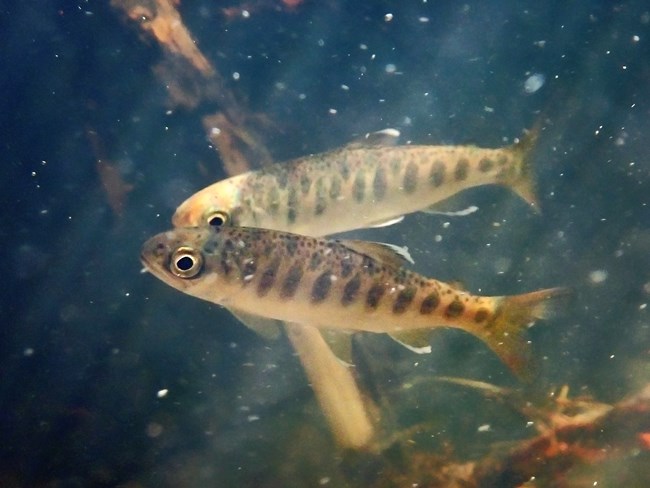Last updated: November 7, 2023
Article
Extreme Home Makeover: Salmon Habitat Project Yielding Impressive Results

NPS / Matt Millado
March 2023 - Three years after implementing Phase 1 of Muir Woods’ salmon habitat enhancement project upstream of Bridge 3, Redwood Creek’s ability to support coho juveniles has vastly improved. Water Year (WY; from October to September) 2021-2022’s annual monitoring report showed increased winter habitat density, more natural sediment deposition, and changes in woody debris placements that led to habitat improvements.
About a century ago, when the National Park Service was more focused on protecting the redwood giants of Muir Woods than the creek meandering through them, the Civilian Conservation Corps built riprap into the stream’s banks. The addition of these large boulders, as well as NPS’s removal of debris and logs, resulted in a homogenous, faster-moving channel with a flattened-out bed.

NPS
While adult coho salmon (Oncorhynchus kisutch) could still spawn in the altered creek, young fry struggled. They need river bends, pools of water, logs and tree roots to safely grow up in the stream. Although a high percentage of salmon in the watershed spawn at Muir Woods, the area produces a small number of juveniles, according to project manager Carolyn Shoulders.
This project is restoring this diversity to the stretch of Redwood Creek flowing through Muir Woods, with hopes of improving the endangered coho population’s survival. Restoration teams are removing riprap from the creek banks and adding small and large wood features to the channel. Without riprap confining its flow, the creek can meander and cut into the bank. This, along with woody structures, creates differences in flow velocity and gives the creek opportunities to scour out pools. Coho juveniles take shelter from high-velocity flows in pools that have some form of overhead cover.
Another consequence of 20th century management was fine sediment washing out of the creek, leaving behind just the larger cobble. But this year, sediment analysis revealed higher variation in grain size, as well as a smaller median grain size. To Shoulders, a greater distribution of sediment size indicates more natural channel processes and healthier hydrology.
The defining event of WY22 was the October 2021 storm. The resulting high flows likely caused woody debris movement, erosion, and the substantial gains in winter habitat reported this year. Conclusions about gains in summer habitat are subject to further analysis.

NPS / Matt Millado

NPS / Matt Millado
Winter habitat mapping and snorkel surveys, where coho juveniles and steelhead trout are counted in a subset of habitat areas, which take place each January or February, also help track the habitat enhancement project’s success. By 2022, the amount of winter habitat where Phase 1 took place reached levels considered to be good. This year, winter habitat levels remained similar. These surveys will also be used as baseline data for Phase 2, where additional creek stretches will be restored.
The vast majority of large woody debris structures that were placed in the creek in 2019 created sheltered pools that serve as good habitat. Woody structures that were secured with vertical, stabilizing pieces stayed in place, while most loose pieces washed downstream. But Redwood Creek still made use of moved or shifted wood.
Some of these pieces wound up by Bridge 3 and Bridge 4, where two log jams grew significantly in WY22. The structure upstream of Bridge 3 gained three large logs and plenty of smaller debris, which led to a pool beneath it over 4.4 feet deep.
While many park projects combat erosion, this project often benefits from it. One log originally placed near Cathedral Grove drifted to the opposite side of the stream and uprooted a maple sapling, which created a cavity in the bank that, when it filled with water, became a habitat pool. In total, three new eroded areas along the bank created winter habitat, the report says.
Phase 2 construction of the habitat enhancement will begin this summer.
“This project should have been done 20 years ago,” Shoulders said. “The changes that we’re making are overdue.”
For more information
- Redwood Creek Salmon Habitat Enhancement Project
- San Francisco Bay Area Network Salmonid Monitoring webpage
- Pacific Coast Science & Learning Center Coho & Steelhead webpage
- Contact Project Manager Carolyn Shoulders or Aquatic Ecologist Darren Fong
See more from the Bay Area Nature & Science Blog
